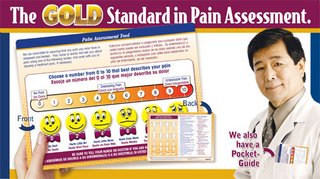
The relationship between physical and emotional illnesses is a really complex one. There's nothing easy about this, and there are psychiatrists who specialize (like Roy) in consultation-liason psychiatry: the interface where psychiatrists deal with psychiatric issues in patients who are hospitalized on med/surg units. There are psychiatrists and neurologists who specialize in pain management.
It's probably no surprise that people with known psychiatric disorders are more easily dismissed by their primary care docs-- their chest pain is assumed to be 'anxiety' and their GI symptoms are due to "stress." It drives me nuts.
This shrink's rule of thumb for medical workups [I hope Dinah doesn't mind me sticking in my 2 cents :-Roy] :
- All symptoms which may be indicative of medical illness should be assumed to be so until proven otherwise. I don't want to see a patient for "panic attacks" until after a thorough work up to rule out cardiovascular or pulmonary disease. What's the work up? Well, it's one thing for an 18 year old girl with no risk factors and a primary complaint of "I feel panicky" and another work-up for a 55 year old smoker with hypertension and a father who died at 54 of an MI who presents with chest pain and shortness of breath on exertion. Don't send the 55 year old smoker with chest pain to see a psychiatrist until after he has a cardiac catheterization! [It's not uncommon to get a consult request to "rule out" conversion disorder when they cannot find a cause for symptoms. Sometimes it is appropriate; others I tell to keep looking.]
- Elusive symptoms are elusive symptoms and should be worked up completely, even if the patient has a psych history.
- Bizarre, non-biologically founded symptoms may require less of a work up--- the classic being "My hair hurts when I pee" or "the machine the aliens inplanted in me is squeezing my thighs." [Though this last example reminds me that people with psychosis get sick, and sometimes interpret their symptoms in a psychotic manner. Don't blow off the alien machine guy's complaint until you've ruled out a blood clot, fracture, or compartment syndrome.]
- Pain syndromes often respond to psychiatric treatments: it doesn't mean the pain wasn't real. Unfortunately, people take this to mean "it was all in your head," and who ever came up with that phrase is not my friend. You can have back pain. It can be real pain and it can really be in your back. Psychiatric treatments may make your pain go away. It was still real pain and it was still in your back. [e.g., tricyclic antidepressants reduce sensitivity to visceral pain]
- Some people have known medical/anatomical reasons for their symptoms and adding psychiatric treatment to the medical regimen helps.
- Some people have extensive workups for an assortment of symptoms: pain, weight loss, diarrhea, migraines, you name it. These can be really extensive work ups running tens of thousands of dollars (or more) with many invasive procedures and nothing is revealed that explains the symptoms. These patients become depressed (this is a very frustrating scenario), and sometimes when the depression is treated, the rest of the symptoms go away. Yes, this really happens, it's profound and it's remarkable. How do you explain this, given that the physical symptoms preceded the depression? I'm left to say that in some people, their stress gets funneled into their body, it's just how they're wired. It doesn't mean their symptoms weren't real, it doesn't mean they are crazy, it doesn't mean it was all in their head, it just means that for them, Depression starts with physical symptoms. Some of these patients do amazingly well, get off their narcotics, and resume normal lives that are no longer controlled by pain/medication regimens/doctor's appointments and tests. If you can't figure out the physical causes for an illness, there should be no shame to looking for a psychological cause. It's sad that there is.





